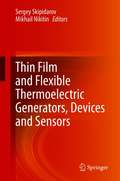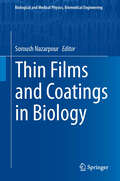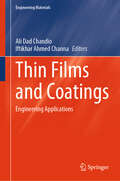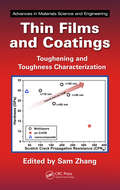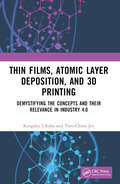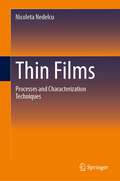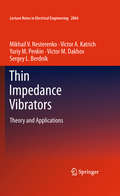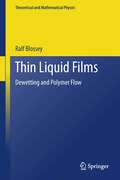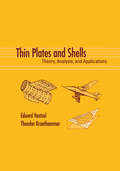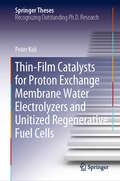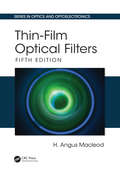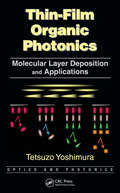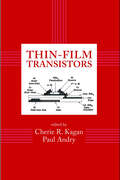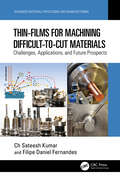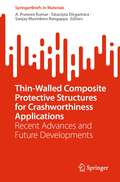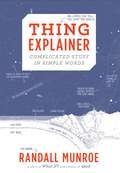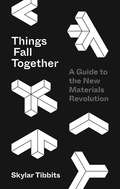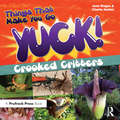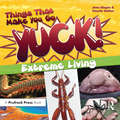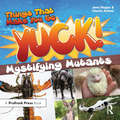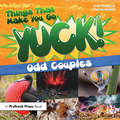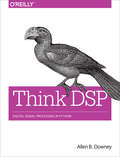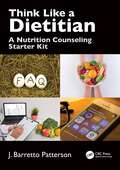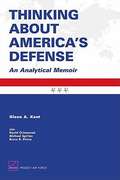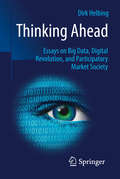- Table View
- List View
Thin Film and Flexible Thermoelectric Generators, Devices and Sensors
by Sergey Skipidarov Mikhail NikitinThis book presents and facilitates new research and development results with hot topics in the thermoelectric generators (TEGs) field. Topics include: novel thin film; multilayer, composite and nanostructured thermoelectric materials; simulation of phenomena related to thermoelectricity; thermoelectric thin film and multilayer materials manufacturing technologies; measurement techniques for characterization; thermoelectric generators; and the simulation, modeling, design, thermal, and mechanical degradation problems. This book helps researchers tackle the challenges that still remain in creating cheap and effective TEGs and presents the latest trends and technologies in development and production of advanced thermoelectric generation devices.
Thin Films and Coatings in Biology
by Soroush NazarpourThe surface of materials is routinely exposed to various environmental influences. Surface modification presents a technological challenge for material scientists, physicists, and engineers, particularly when those surfaces are subjected to function within human body environment. This book provides a comprehensive coverage of the major issues and topics dealing with interaction of soft living matter with the surface of implants. Fundamental scientific concepts are embedded through experimental data and a broad range of case studies. First chapters cover the basics on biocompatibility of many different thin films of metals, alloys, ceramics, hydrogels, and polymers, following with case studies dealing with orthopedic and dental coatings. Next, a novel and low-cost coating deposition technique capable of production of several types of nanostructures is introduced through simple calculations and several illustrations. Moreover, chapter 6 and 7 present important topics on surface treatment of polymers, which is a subject that has seen many developments over the past decade. The last chapters target mainly the applications of coatings in biology such as in bio-sensing, neuroscience, and cancer detection. With several illustrations, micrographs, and case studies along with suitable references in each chapter, this book will be essential for graduate students and researchers in the multidisciplinary field of bio-coatings.
Thin Films and Coatings: Engineering Applications (Engineering Materials)
by Ali Dad Chandio Iftikhar Ahmed ChannaThis book highlights the fundamentals of thin films and coatings, including deposition techniques and material properties. The book showcases real-world applications in electronics, optics, nanotechnology, and aerospace, highlighting how these materials improve performance and durability. It also explores emerging trends such as smart coatings and sustainable options, making it a comprehensive resource for those seeking to leverage the potential of thin films and coatings in engineering. With both theoretical foundations and practical insights, it is a valuable reference for researchers and professionals in this dynamic field.
Thin Films and Coatings: Toughening and Toughness Characterization (Advances in Materials Science and Engineering)
by Ian MuehlenhausThin Films and Coatings: Toughening and Toughness Characterization captures the latest developments in the toughening of hard coatings and in the measurement of the toughness of thin films and coatings. Featuring chapters contributed by experts from Australia, China, Czech Republic, Poland, Singapore, Spain, and the United Kingdom, this book: Presents the current status of hard-yet-tough ceramic coatings Reviews various toughness evaluation methods for films and hard coatings Explores the toughness and toughening mechanisms of porous thin films and laser-treated surfaces Examines adhesions of the film/substrate interface and the characterization of coating adhesion strength Discusses nanoindentation determination of fracture toughness, resistance to cracking, and sliding contact fracture phenomena Toughening and toughness measurement (of films and coatings) are two related, yet separate, fields of great importance in today’s nanotechnology world. Thin Films and Coatings: Toughening and Toughness Characterization is a timely reference written in such a way that novices will find it a stepping stone to the field and veterans will find it a rich source of information for their research.
Thin Films, Atomic Layer Deposition, and 3D Printing: Demystifying the Concepts and Their Relevance in Industry 4.0
by Tien-Chien Jen Kingsley UkobaThin Films, Atomic Layer Deposition, and 3D Printing explains the concept of thin films, atomic layers deposition, and the Fourth Industrial Revolution (4IR) with an aim to illustrate existing resources and give a broader perspective of the involved processes as well as provide a selection of different types of 3D printing, materials used for 3D printing, emerging trends and applications, and current top-performing 3D printers using different technologies. It covers the concept of the 4IR and its role in current and future human endeavors for both experts/nonexperts. The book includes figures, diagrams, and their applications in real-life situations. Features: Provides comprehensive material on conventional and emerging thin film, atomic layer, and additive technologies. Discusses the concept of Industry 4.0 in thin films technology. Details the preparation and properties of hybrid and scalable (ultra) thin materials for advanced applications. Explores detailed bibliometric analyses on pertinent applications. Interconnects atomic layer deposition and additive manufacturing. This book is aimed at researchers and graduate students in mechanical, materials, and metallurgical engineering.
Thin Films: Processes and Characterization Techniques
by Nicoleta NedelcuThe book provides research scientists and engineers in industry information and data on the materials processing, characterization, and determination of materials’ physical-chemical properties. The book highlights optical and chemical properties obtained on novel materials using a range of deposition methods by two different spectroscopic techniques: SE and UV-VIS-NIR. Emphasizing applications from across a number of domains including Healthcare, Opto-Electronic, and Defense, the book is ideal for academic researchers, graduate/undergraduate students, and practicing engineers concerned with optical coating technologies.
Thin Impedance Vibrators
by Victor A. Katrich Yuriy M. Penkin Sergey L. Berdnik Mikhail V. Nesterenko Victor M. DakhovThe book is devoted to exploring the foundations of the theory of thin impedance vibrator antennas. The text provides a continuation of the classic theory of thin perfectly conducting vibrators. Many consider impedance conception one of the most universal models in the theory of wave processes, as it informs such a wide spectrum of uses in solving practical problems of electrodynamics. This topic provides an opportunity to further search analytical solutions, allowing a simplification of the mathematical formulation of the boundary problem. The theory strives to widen the boundaries of the impedance vibrator antennas application in complex modern radio-and-electronic systems and devices. The results of much original research conducted by the authors will be useful for practicing engineers and designers of antenna and waveguide systems. The book is written in an academic style, and can be used to teach students and post graduates about radiotechnical and radiophysical specialities. The conclusion of the book lists many actual applied problems, which can provide inspiration for several potential PhD projects. Topics covered in this book are: *general questions of the theory of impedance vibrators in the spatial-frequency representation *electromagnetic waves radiation by impedance vibrators in free space and material mediums *electromagnetic waves radiation by impedance vibrators in material mediums over the perfectly conducting plane *electromagnetic waves scattering by irregular impedance vibrators in free space *generalized method of induced electromotive forces for investigation of the characteristics of impedance vibrators *radiation of electromagnetic waves by radial impedance vibrators on the perfectly conducting sphere *electromagnetic waves scattering by impedance vibrators in the rectangular waveguide
Thin Liquid Films
by Ralf BlosseyThis book is a treatise on the thermodynamic and dynamic properties of thin liquid films at solid surfaces and, in particular, their rupture instabilities. For the quantitative study of these phenomena, polymer thin films (sometimes referred to as "ultrathin") have proven to be an invaluable experimental model system. What is it that makes thin film instabilities special and interesting? First, thin polymeric films have an important range of applications. An understanding of their instabilities is therefore of practical relevance for the design of such films. The first chapter of the book intends to give a snapshot of current applications, and an outlook on promising future ones. Second, thin liquid films are an interdisciplinary research topic, which leads to a fairly heterogeneous community working on the topic. It justifies attempting to write a text which gives a coherent presentation of the field which researchers across their specialized communities might be interested in. Finally, thin liquid films are an interesting laboratory for a theorist to confront a well-established theory, hydrodynamics, with its limits. Thin films are therefore a field in which a highly fruitful exchange and collaboration exists between experimentalists and theorists. The book stretches from the more concrete to more abstract levels of study: we roughly progress from applications via theory and experiment to rigorous mathematical theory. For an experimental scientist, the book should serve as a reference and guide to what is the current consensus of the theoretical underpinnings of the field of thin film dynamics. Controversial problems on which such a consensus has not yet been reached are clearly indicated in the text, as well as discussed in a final chapter. From a theoretical point of view, the field of dewetting has mainly been treated in a mathematically 'light' yet elegant fashion, often making use of scaling arguments. For the untrained researcher, this approach is not always easy to follow. The present book attempts to bridge between the 'light' and the 'rigorous', always with the ambition to enhance insight and understanding - and to not let go the elegance of the theory.
Thin Plates and Shells: Theory: Analysis, and Applications
by Eduard Ventsel Theodor KrauthammerPresenting recent principles of thin plate and shell theories, this book emphasizes novel analytical and numerical methods for solving linear and nonlinear plate and shell dilemmas, new theories for the design and analysis of thin plate-shell structures, and real-world numerical solutions, mechanics, and plate and shell models for engineering applications. It includes computer processes for finite difference, finite element, boundary element, and boundary collocation methods as well as other variational and numerical methods. It also contains end-of-chapter examples and problem/solution sets, a catalog of solutions for cylindrical and spherical shells, and tables of the most commonly used plates and shells.
Thin-Film Catalysts for Proton Exchange Membrane Water Electrolyzers and Unitized Regenerative Fuel Cells (Springer Theses)
by Peter KúšThis work revolves around the hydrogen economy and energy-storage electrochemical systems. More specifically, it investigates the possibility of using magnetron sputtering for deposition of efficient thin-film anode catalysts with low noble metal content for proton exchange membrane water electrolyzers (PEM-WEs) and unitized regenerative fuel cells (PEM-URFCs). The motivation for this research derives from the urgent need to minimize the price of such electrochemical devices should they enter the mass production. Numerous experiments were carried out, correlating the actual in-cell performance with the varying position of thin-film catalyst within the membrane electrode assembly, with the composition of high-surface support sublayer and with the chemical structure of the catalyst itself. The wide arsenal of analytical methods ranging from electrochemical impedance spectroscopy through electrochemical atomic force microscopy to photoelectron spectroscopy allowed a description of the complex phenomena behind different obtained efficiencies. Systematic optimizations led to the design of a novel PEM-WE anode thin-film iridium catalyst which performs similarly to the standard counterparts despite using just a fraction of their noble metal content. Moreover, the layer-by-layer approach allowed the design of a Pt/TiC/Ir bi-functional anode for PEM-URFC which is able to operate in both the fuel cell and electrolyzer regime and thus helps to cut the cost of the whole conversion system even further.
Thin-Film Optical Filters (Series in Optics and Optoelectronics)
by H. Angus MacleodPraise for prior editions "an excellent treatise of thin film coatings, explaining how to produce all sorts of different filters selected according to the function they are required to play… an indispensable text for every filter manufacturer and user and an excellent guide for students." ―Contemporary Physics "essential reading for all those involved in the design, manufacture, and application of optical coatings" ―Materials World "a must-have addition to the library of any optical thin-film theorist or practitioner" ―SVC News This book is quite simply the Bible for the field of optical thin films. It gives the most complete introduction to thin film optical coatings addressed to manufacturers and users alike. This fifth edition offers a complete update on current design, manufacture, performance, and applications. New topics include absorbers and coherent perfect absorbers, photonic crystals, and metamaterials for optical coating. The author has also made substantial additions on scattering, composite materials, wire grid polarizers, laser damage, and applications. H. Angus Macleod is President of Thin Film Center Inc., in Tucson, Arizona, and Professor Emeritus of Optical Sciences Center at the University of Arizona. His professional honors include a Gold Medal from SPIE, the Esther Hoffman Beller Medal from the Optical Society of America, and the Nathaniel H. Sugerman Memorial Award from the Society of Vacuum Coaters.
Thin-Film Organic Photonics: Molecular Layer Deposition and Applications (Optics and Photonics)
by Tetsuzo YoshimuraAmong the many atomic/molecular assembling techniques used to develop artificial materials, molecular layer deposition (MLD) continues to receive special attention as the next-generation growth technique for organic thin-film materials used in photonics and electronics. Thin-Film Organic Photonics: Molecular Layer Deposition and Applications describes how photonic/electronic properties of thin films can be improved through MLD, which enables precise control of atomic and molecular arrangements to construct a wire network that achieves "three-dimensional growth". MLD facilitates dot-by-dot—or molecule-by-molecule—growth of polymer and molecular wires, and that enhanced level of control creates numerous application possibilities. Explores the wide range of MLD applications in solar energy and optics, as well as proposed uses in biomedical photonics This book addresses the prospects for artificial materials with atomic/molecular-level tailored structures, especially those featuring MLD and conjugated polymers with multiple quantum dots (MQDs), or polymer MQDs. In particular, the author focuses on the application of artificial organic thin films to: Photonics/electronics, particularly in optical interconnects used in computersOptical switching and solar energy conversion systems Bio/ medical photonics, such as photodynamic therapy Organic photonic materials, devices, and integration processes With its clear and concise presentation, this book demonstrates exactly how MLD enables electron wavefunction control, thereby improving material performance and generating new photonic/electronic phenomena.
Thin-Film Transistors
by Cherie R. Kagan Paul AndryThis is a single-source treatment of developments in TFT production from international specialists. It interweaves overlapping areas in multiple disciplines pertinent to transistor fabrication and explores the killer application of amorphous silicon transistors in active matrix liquid crystal displays. It evaluates the preparation of polycrystallin
Thin-Films for Machining Difficult-to-Cut Materials: Challenges, Applications, and Future Prospects (Advanced Materials Processing and Manufacturing)
by Ch Sateesh Kumar Filipe Daniel FernandesThis book presents a balanced blend of fundamental research such as principles and characteristics of machining of difficult-to-cut materials and coating techniques and in-depth practical information on coatings techniques and classifications, the effect of coating parameters on machining responses, and finite element analysis of the machining performance of coated tools. In addition to the benefits of the thin-film deposition on the cutting tools, the limitations of the coating deposition techniques and the coating properties are also discussed. Features: Associates the application of coating technology for improving machining characteristics of difficult-to-cut materials. Elaborates effect of coating architecture on the output machining parameters. Explores the performance of coated cutting tools. Discusses advanced coating systems and their application. Includes industrial case studies and practical implementations where coatings were applied for the machining of difficult-to-cut materials. This book is aimed at researchers and graduate students in thin-films, coatings, machining, materials engineering, and manufacturing.
Thin-Walled Composite Protective Structures for Crashworthiness Applications: Recent Advances and Future Developments (SpringerBriefs in Materials)
by Sanjay Mavinkere Rangappa A. Praveen Kumar Tatacipta DirgantaraThis book summarizes many of the recent advances in the design and application of thin-walled composite protective structures. The past few decades have seen outstanding advances in the use of composite materials in structural applications. Composites have revolutionized traditional design concepts and made possible an unparalleled range of new and exciting possibilities as viable materials for construction. This book presents an extensive survey on recent improvements in the research and development of composites and biocomposites that are used to make structures in various applications. This book deals with design, research and development studies, experimental investigations, theoretical analysis, and fabrication techniques relevant to the application of composites in load-bearing components for assemblies, ranging from individual components such as plates and shells to complete composite structures. This book also focuses the recent advances in biocomposite materials from renewable resources and introduces a potential application of this material. The content is this book benefits the academics, researchers, scientists, engineers, and students in the field of epoxy blends for application as lightweight advanced composite structures.
Thing Explainer
by Randall MunroeHave you ever tried to learn more about some incredible thing, only to be frustrated by incomprehensible jargon? Randall Munroe is here to help. In Thing Explainer, he uses line drawings and only the thousand (or, rather, "ten hundred") most common words to provide simple explanations for some of the most interesting stuff there is, including:food-heating radio boxes (microwaves)tall roads (bridges)computer buildings (datacenters)the shared space house (the International Space Station)the other worlds around the sun (the solar system)the big flat rocks we live on (tectonic plates)the pieces everything is made of (the periodic table)planes with turning wings (helicopters)boxes that make clothes smell better (washers and dryers)the bags of stuff inside you (cells) How do these things work? Where do they come from? What would life be like without them? And what would happen if we opened them up, heated them up, cooled them down, pointed them in a different direction, or pressed this button? In Thing Explainer, Munroe gives us the answers to these questions and so many more. Funny, interesting, and always understandable, this book is for anyone--age 5 to 105--who has ever wondered how things work, and why.
Things Fall Together: A Guide to the New Materials Revolution
by Skylar TibbitsFrom the visionary founder of the Self-Assembly Lab at MIT, a manifesto for the dawning age of active materialsThings in life tend to fall apart. Cars break down. Buildings fall into disrepair. Personal items deteriorate. Yet today's researchers are exploiting newly understood properties of matter to program materials that physically sense, adapt, and fall together instead of apart. These materials open new directions for industrial innovation and challenge us to rethink the way we build and collaborate with our environment. Things Fall Together is a provocative guide to this emerging, often mind-bending reality, presenting a bold vision for harnessing the intelligence embedded in the material world.Drawing on his pioneering work on self-assembly and programmable material technologies, Skylar Tibbits lays out the core, frequently counterintuitive ideas and strategies that animate this new approach to design and innovation. From furniture that builds itself to shoes printed flat that jump into shape to islands that grow themselves, he describes how matter can compute and exhibit behaviors that we typically associate with biological organisms, and challenges our fundamental assumptions about what physical materials can do and how we can interact with them. Intelligent products today often rely on electronics, batteries, and complicated mechanisms. Tibbits offers a different approach, showing how we can design simple and elegant material intelligence that may one day animate and improve itself—and along the way help us build a more sustainable future.Compelling and beautifully designed, Things Fall Together provides an insider's perspective on the materials revolution that lies ahead, revealing the spectacular possibilities for designing active materials that can self-assemble, collaborate, and one day even evolve and design on their own.
Things That Make You Go Yuck!: Crooked Critters
by Jennifer Dlugos Charlie HattonNature doesn't always play nice, and Things That Make You Go Yuck!: Crooked Critters showcases some of the worst offenders in the plant and animal kingdoms. You'll meet trespassing toads, insects in disguise, brood-borrowing cuckoos, and many more. It's a rogue's gallery of some of nature's roughest, meanest species. Whether it's nature's slimiest organisms or the weirdest mutations, Things That Make You Go Yuck! celebrates survival of the fittest, grossest, craziest, and creepiest things in nature, proving once and for all that life in the wild is anything but ordinary.Ages 9-12
Things That Make You Go Yuck!: Extreme Living
by Jennifer Dlugos Charlie HattonLife isn't always easy, but some organisms take hard living to the extreme. Things That Make You Go Yuck!: Extreme Living looks at organisms living in the weirdest of ways: swimming miles deep in the ocean, freezing on icy mountaintops, boiling in hot springs, or even floating in space. You'll also find critters bigger, smaller, softer, longer, and stretchier than you ever thought possible. Whether it's nature's slimiest organisms or the weirdest mutations, Things That Make You Go Yuck! celebrates survival of the fittest, grossest, craziest, and creepiest things in nature, proving once and for all that life in the wild is anything but ordinary.Ages 9-12
Things That Make You Go Yuck!: Mystifying Mutants
by Jennifer Dlugos Charlie HattonHexapus. Singing mice. Spider worm. They sound like creatures from horror movies, but they are all real-life mutants that creep, crawl, and slither among us. In Things That Make You Go Yuck!: Mystifying Mutants, you'll learn that genes can be a freaky and fascinating business. From two-toned lobsters to hairless cats, this book showcases the strangest and most shocking genetic mutants in the plant and animal kingdoms. Whether it's nature's slimiest organisms or the weirdest mutations, Things That Make You Go Yuck! celebrates survival of the fittest, grossest, craziest, and creepiest things in nature, proving once and for all that life in the wild is anything but ordinary.Ages 9-12
Things That Make You Go Yuck!: Odd Couples
by Jennifer Dlugos Charlie HattonIt takes two to tango—but in the wild, two can do much crazier things than dance. In Things That Make You Go Yuck!: Odd Couples, you'll find out about nature's strangest dating rituals, cooperative couples, and parasitic pests. You'll explore symbiotic pairings like crabs that carry sea urchins on their backs, and hybrid “franken-species” that seem like something out of a science-fiction tale. Whether it's nature's slimiest organisms or the weirdest mutations, Things That Make You Go Yuck! celebrates survival of the fittest, grossest, craziest, and creepiest things in nature, proving once and for all that life in the wild is anything but ordinary.Ages 9-12
Think DSP: Digital Signal Processing in Python
by Allen B. DowneyIf you understand basic mathematics and know how to program with Python, you’re ready to dive into signal processing. While most resources start with theory to teach this complex subject, this practical book introduces techniques by showing you how they’re applied in the real world. In the first chapter alone, you’ll be able to decompose a sound into its harmonics, modify the harmonics, and generate new sounds.Author Allen Downey explains techniques such as spectral decomposition, filtering, convolution, and the Fast Fourier Transform. This book also provides exercises and code examples to help you understand the material.You’ll explore:Periodic signals and their spectrumsHarmonic structure of simple waveformsChirps and other sounds whose spectrum changes over timeNoise signals and natural sources of noiseThe autocorrelation function for estimating pitchThe discrete cosine transform (DCT) for compressionThe Fast Fourier Transform for spectral analysisRelating operations in time to filters in the frequency domainLinear time-invariant (LTI) system theoryAmplitude modulation (AM) used in radioOther books in this series include Think Stats and Think Bayes, also by Allen Downey.
Think Like a Dietitian: A Nutrition Counseling Starter Kit
by J. Barretto PattersonWhile courses in nutrition counseling teach providers to listen to their patients, this book gives registered dietitian nutritionists (RDNs) a heads-up on what to listen for, with educational materials that address the everyday challenges many people, hence many RDNs, face.Split into four distinct sections, this book equips readers with comprehensive education and counseling for the most common nutrition referrals.Topics include:- How to structure a nutrition counseling session, from getting a patient to open up to empowering them with information and strategies for self‑care.- Strategies for the provider to address personal challenges such as cultivating empathy, implicit bias, and cultural competence.- Routine eating patterns and challenges reported in nutrition counseling, such as night eating, emotional eating, and more.- Common reasons for referral to a dietitian, and frequently asked questions on topics including diabetes, heart disease, kidney disease, irritable bowel syndrome, and weight counseling.- Special issues in health educationThis book is appealing to both early nutrition professionals and experienced dietitians alike, providing a holistic tool kit for RDNs of all levels of experience.
Thinking About America's Defense
by David R. Frelinger Glenn A. KentLieutenant General Glenn A. Kent was a uniquely acute analyst and developerof American defense policy in the second half of the twentieth century. His33-year career in the Air Force was followed by more than 20 years as one ofthe leading analysts at RAND. This volume is not a memoir in the normalsense but rather a summary of the dozens of national security issues inwhich Glenn was personally engaged over the course of his career. Theseissues included creating the single integrated operational plan (SIOP),leading DoD's official assessment of strategic defenses in the 1960s,developing and analyzing strategic nuclear arms control agreements, helpingto bring new weapon systems to life, and many others. Each vignettedescribes the analytical frameworks and, where appropriate, the mathematicalformulas and charts that Glenn developed and applied to gain insights intothe issue at hand. The author also relates his roles in much of thebureaucratic pulling and hauling that occurred as issues were addressedwithin the government.
Thinking Ahead - Essays on Big Data, Digital Revolution, and Participatory Market Society
by Dirk HelbingThe rapidly progressing digital revolution is now touching the foundations of the governance of societal structures. Humans are on the verge of evolving from consumers to prosumers, and old, entrenched theories – in particular sociological and economic ones – are falling prey to these rapid developments. The original assumptions on which they are based are being questioned. Each year we produce as much data as in the entire human history - can we possibly create a global crystal ball to predict our future and to optimally govern our world? Do we need wide-scale surveillance to understand and manage the increasingly complex systems we are constructing, or would bottom-up approaches such as self-regulating systems be a better solution to creating a more innovative, more successful, more resilient, and ultimately happier society? Working at the interface of complexity theory, quantitative sociology and Big Data-driven risk and knowledge management, the author advocates the establishment of new participatory systems in our digital society to enhance coordination, reduce conflict and, above all, reduce the “tragedies of the commons,” resulting from the methods now used in political, economic and management decision-making. The authorPhysicist Dirk Helbing is Professor of Computational Social Science at the Department of Humanities, Social and Political Sciences and an affiliate of the Computer Science Department at ETH Zurich, as well as co-founder of ETH’s Risk Center. He is internationally known for the scientific coordination of the FuturICT Initiative which focuses on using smart data to understand techno-socio-economic systems. “Prof. Helbing has produced an insightful and important set of essays on the ways in which big data and complexity science are changing our understanding of ourselves and our society, and potentially allowing us to manage our societies much better than we are currently able to do. Of special note are the essays that touch on the promises of big data along with the dangers...this is material that we should all become familiar with!” Alex Pentland, MIT, author of Social Physics: How Good Ideas Spread - The Lessons From a New Science "Dirk Helbing has established his reputation as one of the leading scientific thinkers on the dramatic impacts of the digital revolution on our society and economy. Thinking Ahead is a most stimulating and provocative set of essays which deserves a wide audience.” Paul Ormerod, economist, and author of Butterfly Economics and Why Most Things Fail. "It is becoming increasingly clear that many of our institutions and social structures are in a bad way and urgently need fixing. Financial crises, international conflicts, civil wars and terrorism, inaction on climate change, problems of poverty, widening economic inequality, health epidemics, pollution and threats to digital privacy and identity are just some of the major challenges that we confront in the twenty-first century. These issues demand new and bold thinking, and that is what Dirk Helbing offers in this collection of essays. If even a fraction of these ideas pay off, the consequences for global governance could be significant. So this is a must-read book for anyone concerned about the future." Philip Ball, science writer and author of Critical Mass “This collection of papers, brought together by Dirk Helbing, is both timely and topical. It raises concerns about Big Data, which are truly frightening and disconcerting, that we do need to be aware of; while at the same time offering some hope that the technology, which has created the previously unthought-of dangers to our privacy, safety and democracy can be the means to address these dangers by enabling social, economic and political participation and coordination, not possible in the past. It makes for compelling reading and I hope for timely action.”Eve Mitleton-Kelly, LSE, author of Corporate Governance and Complexity Theory and editor of Co-evolution of Intelligent Socio-
